Related Research Articles
A doxology is a short hymn of praises to God in various forms of Christian worship, often added to the end of canticles, psalms, and hymns. The tradition derives from a similar practice in the Jewish synagogue, where some version of the Kaddish serves to terminate each section of the service.

Contemporary worship music (CWM), also known as praise and worship music, is a defined genre of Christian music used in contemporary worship. It has developed over the past 60 years and is stylistically similar to pop music. The songs are frequently referred to as "praise songs" or "worship songs" and are typically led by a "worship band" or "praise team", with either a guitarist or pianist leading. It has become a common genre of music sung in many churches, particularly in charismatic or non-denominational Protestant churches with some Roman Catholic congregations incorporating it into their mass as well.
Hallelujah is an interjection used as an expression of gratitude and adoration. The term is used 24 times in the Hebrew Bible, twice in deuterocanonical books, and four times in the Christian Book of Revelation.

A metrical psalter is a kind of Bible translation: a book containing a verse translation of all or part of the Book of Psalms in vernacular poetry, meant to be sung as hymns in a church. Some metrical psalters include melodies or harmonisations. The composition of metrical psalters was a large enterprise of the Protestant Reformation, especially in its Calvinist manifestation.
John Henry Maunder was an English composer and organist best known for his cantata "Olivet to Calvary".

"Christ the Lord Is Risen Today" is a Christian hymn associated with Easter. Most of the stanzas were written by Charles Wesley, and the hymn appeared under the title "Hymn for Easter Day" in Hymns and Sacred Poems by Charles and John Wesley in 1739. The hymn eventually became well known for the "Alleluia" sung as a melisma after each line, which was added by an unknown author, probably to fit the commonly used hymn tune, "Easter Hymn". It remains a traditional processional hymn on Easter Sunday.

"Come Thou Fount of Every Blessing" is a Christian hymn written by the pastor and hymnodist Robert Robinson, who penned the words in the year 1758 at the age of 22.
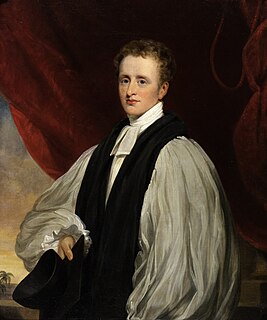
"Holy, Holy, Holy! Lord God Almighty!" is a Christian hymn written by the Anglican bishop Reginald Heber (1783–1826).
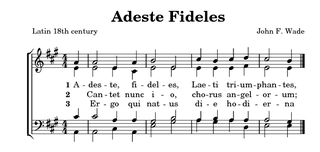
A hymn tune is the melody of a musical composition to which a hymn text is sung. Musically speaking, a hymn is generally understood to have four-part harmony, a fast harmonic rhythm, with or without refrain or chorus.
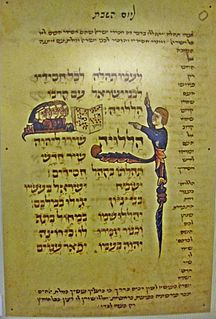
Psalm 149 is the 149th psalm of the Book of Psalms, a hymn as the book's penultimate piece. The first verse of the psalm calls to praise in singing, in English in the King James Version: "Sing a new song unto the Lord". Similar to Psalm 96 and Psalm 98, Psalm 149 calls to praise God in music and dance, because he has chosen his people and helped them to victory. Psalm 149 also calls to be ready to fight.
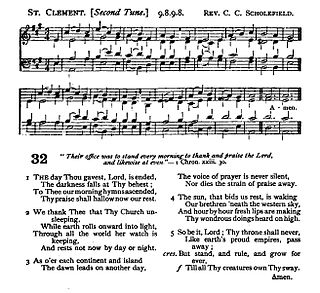
The day thou gavest, Lord, is ended is a Christian hymn written by the Anglican hymnodist the Rev John Ellerton (1826–1893) in 1870 for its inclusion in A Liturgy for Missionary Meetings. It is often sung to the tune of St Clement and its theme focusses on the worldwide fellowship of the church and its continual offering of prayer and praise to God.

"Praise, my soul, the King of heaven" is a Christian hymn. Its text, which draws from Psalm 103, was written by Anglican divine (clergyman) Henry Francis Lyte. First published in 1834, it endures in modern hymnals to a setting written by John Goss in 1868, and remains one of the most popular hymns in English-speaking denominations.

"Gelobt sei Gott im höchsten Thron" is a hymn for Easter in 20 stanzas in German by Michael Weiße, widely known with a later melody by Melchior Vulpius. Shortened, it is part of current Protestant and Catholic German hymnals.

"Christ ist erstanden" is a German Easter hymn, and is possibly the oldest Christian liturgical German song. It has inspired music by composers such as Ludwig Senfl and Heinrich Schütz through to modern composers such as Oskar Gottlieb Blarr and Enjott Schneider, and has appeared in 45 hymnals, including the current German Catholic and Protestant hymnals. Translations and paraphrases include a version by Catherine Winkworth which has appeared in 231 hymnals. "Christ ist erstanden" also inspired Martin Luther to write "Christ lag in Todes Banden", deriving the melody from it.
"Good Christians All, Rejoice and Sing", originally titled "Good Christian Men, Rejoice", is an English Christian hymn written by Cyril Alington. It was first published in 1931 and is mostly used as an Easter hymn.
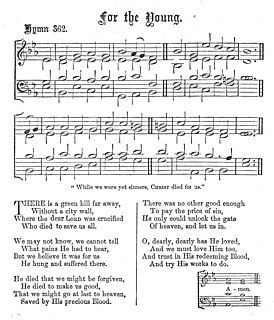
"There is a green hill far away" is a Christian hymn, originally written as a children's hymn but now usually sung for Passiontide. The words are by Cecil Frances Alexander, and the most popular tune by William Horsley.
"Ik sta voor U in leegte en gemis" is a Christian hymn with Dutch text by Huub Oosterhuis. The melody was composed by Bernard Huijbers.

Activists and artists taking part in the 2019–2020 Hong Kong protests use artwork, painting, music, and other forms of artistic expression as a tactic to help spread awareness about the events that have happened in the city. Individuals who create protest art are commonly referred to as the "publicity group" (文宣組). Creating protest art is seen as a peaceful, alternative way for citizens to express their views without participating in protests. Most members work under pseudonyms to protect their identity and stay in line with the movement's leaderless nature.

"Glory to Hong Kong" is a march that was composed and written by a musician under the pseudonym "Thomas dgx yhl", with the contribution of a group of Hongkonger netizens from the online forum LIHKG during the 2019–2020 Hong Kong protests. It was initially written in Cantonese and was eventually developed into various language versions. It has been adopted as the anthem of these protests, with some considering it the "national anthem of Hong Kong".
References
- ↑ William Petersen, Ardythe Petersen The Complete Book of Hymns 1414331401 2015 p.74 "Everything seemed to be centered around Calvary Chapel in Costa Mesa, including music classes. So twenty-three year-old Linda Stassen got involved with a recording group and a music composition class. ... The simplicity of the words and the beauty of the tune have made it popular in languages around the world, including Chinese, Persian, Eskimo, and various European languages."
- ↑ Lift Up Your Hearts unto the Lord Archived 2019-06-29 at the Wayback Machine , hymnary.org
- ↑ Leslie Clay Sisters In Song; Women Hymn Writers 193668876X Archived 2018-05-10 at the Wayback Machine 2013 "Stassen-Benjamin. 1951 “Sing. Hallelujah”. Linda was born in La Porte, Indiana, ... She composed the song, “Sing Hallelujah” in 1974 while she was taking a shower. .. After that, she recorded it and it's now in many hymnals and translated in many languages. It is in a minor key, unusual for a praise son. However, the key works well with the first four stanzas which are derived from early Christian liturgies."
- ↑ Marilyn L. Haskel, Lisa Neufeld Thomas Voices Found 2004 0898693683 p.115 "Sing hallelujah Written in 1974 as part of the contemporary Christian music movement, this meditative song of praise for the Easter season has become a staple for prayer and praise services. The tempo is approximately quarter note "
- ↑ Leung, Hillary (June 19, 2019). "A 1974 Hymn Called 'Sing Hallelujah to the Lord' Has Become the Anthem of the Hong Kong Protests". Time.com. Archived from the original on June 20, 2019. Retrieved June 19, 2019.
- ↑ S.R. (June 14, 2019). "Do you hear the people sing? Not in China". The Economist. ISSN 0013-0613. Archived from the original on June 15, 2019. Retrieved June 15, 2019.
- ↑ Hong Kong Christians turn 'Sing Hallelujah to the Lord' into unlikely protest anthem Archived 2019-06-20 at the Wayback Machine , ABC News, 20 June 2019
- ↑ Il est vivant !: Carnet de chants L'Emmanuel 2007 p.107
- ↑ El himnario presbiteriano, Geneva Press, Presbyterian Publishing Corporation 0664500145 1999 p.166
